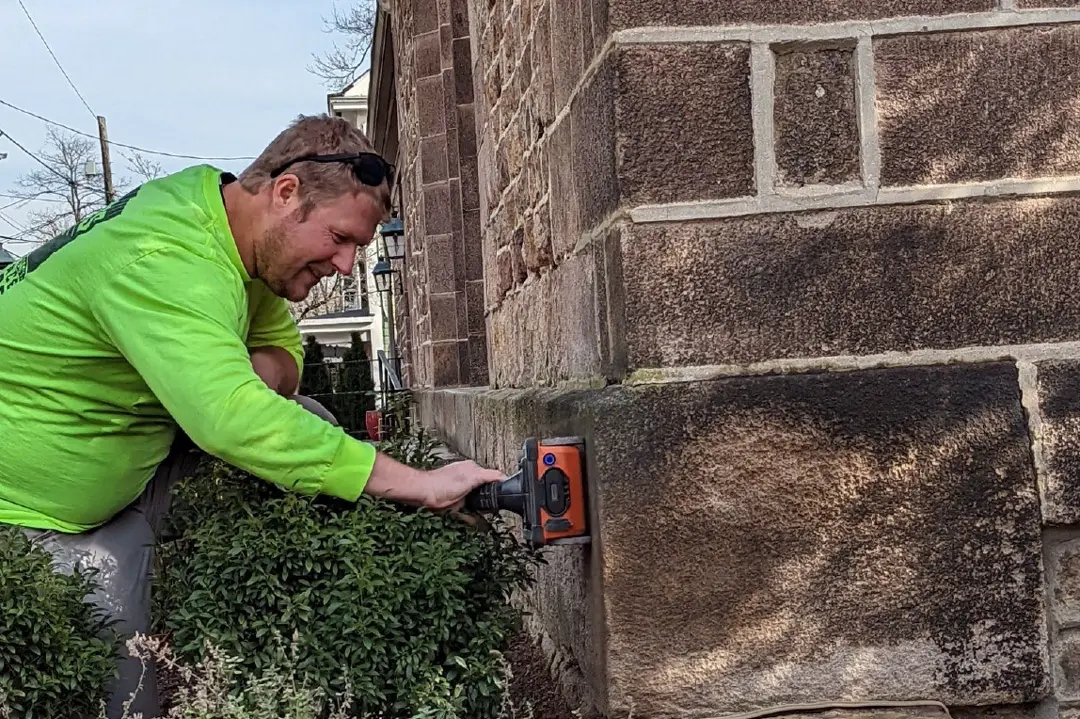“We just went above and beyond, by doing our standard process.” – Patrick Hughes, GPRS Field Services Manager

It’s not every day that GPRS investigates a nearly 175-year-old stone church to see if a historical treasure trove might be buried within its foundation.
Yet that’s exactly what happened when Field Services Manager Patrick Hughes and Area Manager Sam Hart were called to Saint Paul’s Episcopal Church in Doylestown Borough, Pennsylvania.
The church’s 175th anniversary committee contacted GPRS to request that we scan the building’s cornerstone, which is said to conceal a large box containing important artifacts tied to the church’s founding.
According to the Bucks County Herald, Saint Paul’s is the fourth-oldest church in Doylestown Borough. It was consecrated on September 9, 1846.
Situated about an hour north of Philadelphia, the Borough of Doylestown is the seat of Bucks County, Pennsylvania. According to its website, Doylestown was recognized by USA Today as having America’s “best small-town cultural scene.”
Supposedly included in the Saint Paul treasure trove are The Holy Bible, The Book of Common Prayer; the Journal of the General Convention of the Protestant Episcopal Church held in Philadelphia in 1844; the Journal of the General Convention of the Episcopal Church of the Diocese of Pennsylvania; Bishop Potter’s Primary Charge of the Convention, together with his Pastoral Letter; the last number of the Episcopal Recorder; and the Banner of the Cross.
Church leaders hoped that GPRS could gather data that either supported or debunked the story before they attempted any potentially destructive methods of looking under the limestone block.
“They didn’t want to just go blindly chipping around,” Hughes said.
GPR professional services are sometimes utilized on popular television shows that focus on the search for ancient artifacts. GPRS has assisted with some of these investigations in the past, including appearing on the CW’s Mysteries Decoded series to help uncover the secrets of a Rhode Island home that predates the American Revolution.
Even so, it’s rare that a legend about buried treasure turns out to be true. That’s why Hughes and Hart were a bit skeptical of what they’d find at Saint Paul’s.
“We don’t get these calls too often, but most of the time when we do, we’re trying to find a needle in a haystack,” Hart said. “When Patrick asked me to go, I kind of had the mindset of like ‘Yeah, I’ll go, but I don’t expect to find anything.’”
GPRS team members bring the same level of professionalism to their craft whether they’re scanning a concrete slab for rebar, post-tension cables and utilities, or searching for hidden secrets in an ancient building.
Hughes said that he and Hart conducted GPRS’ “standard, thorough investigatory process” at Saint Paul’s, scanning the area in question with a StructureScanTM Mini XT handheld GPR system.
The two were amazed at what they found.

“We found something in the middle of the stone, but it was not very distinctive,” Hart said. “Then we got closer to the edge, and we were seeing something. I think it was about three inches in and it was right on the corner. We were able to scan both corners that met together to see if they were consistent, which they were, and then we marked it out with tape.”
Both Project Managers said that the anomaly they detected with their equipment was “pretty significant.”
To ensure the accuracy of their find, the duo scanned the stones adjacent to the cornerstone to make sure they weren’t getting a false reading. None of their scans came back with similar findings, which verified the original scan.
“It was jumping out at us, for sure,” Hughes added.
The church will take the data collected by GPRS and consult a structural engineer before moving forward with further examination of the cornerstone. GPRS will continue to assist on the project, and Hughes and Hart plan to be on site when the chamber is eventually accessed.
“It was pretty exciting, what we were seeing,” Hart said. “I feel pretty confident that there’s something there. Whether it’s relevant or not, it’s hard to say.”
GPRS is helping to solve a 175-year-old mystery. As is the case anytime our team members perform a GPR scan, The Project Managers’ efforts helped the members of Saint Paul’s Episcopal Church Visualize The Built WorldTM in a safe, effective, and non-destructive manner.
Said Hughes: “We just went above and beyond, by doing our standard process.”
What can we help you visualize?



.svg)